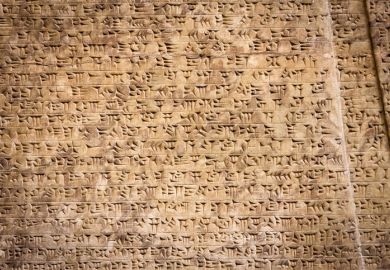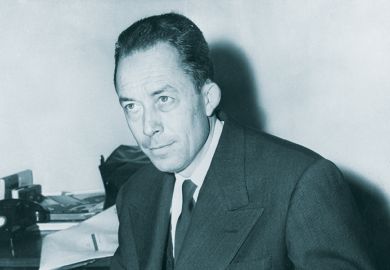Don’t ever be fooled by the idea of Cummings the rebel," the critic Edmund Wilson observed in the 1930s. Just how right he was is made absolutely clear in this life by Christopher Sawyer-Lauçanno. For what emerges from E. E. Cummings: A Biography is a portrait of the poet as a bohemian conservative, or, in the accurate assessment of his first wife, "an advanced poet and a reactionary".
This long (perhaps overlong) study is woven from two alternating narrative strands. The first, properly biographical, offers a blow-by-blow account of Cummings’s personal life, enriched by patient trawling through some 400 boxes of the poet’s previously inaccessible private papers. The second presents his creative work as an innovative and much anthologised poet, and an active but largely derivative and unsuccessful fine artist.
Cummings was the son of a successful New England family, and he depended for most of his life on their financial support, although the patronage of friends also helped. Writing in 1922, in response to his father’s advice to get a job, Cummings replies: "I am not, and do not anticipate being self-supporting." His prediction — interestingly halfway between doomed recognition and proud intention — proved
to be largely correct. Fifteen years later, at 43, he was still dependent enough to blow the $400 advance on his first Collected Poems on a trip to Europe and confidently demand a further $530 from his mother and friends to pay for his trip home. As he acknowledged, somewhat ruefully, "America doesn’t want poems badly enough to make it a profitable business to be engaged in."
Though highly regarded from the 1920s onwards by fellow poets such as Ezra Pound, William Carlos Williams and Marianne Moore, it was only in the 1950s that
he gained a substantial measure of success and recognition. The main agent appears to have been the six "lectures" he delivered as Charles Eliot Norton professor at Harvard University in 1952-53. Despite or perhaps because of their very slight intellectual content — they simply presented Cummings’s opinions on individuality and poetry without feeling the need to argue a case — these non-lectures were hugely successful. Their subsequent publication assured Cummings a place on the emerging poetry-reading circuits and in the undergraduate anthologies that were fast becoming the main currency of canonical recognition, as the structures of modernist consciousness began to look different to a postwar generation.
In the introduction to the 1938 edition of his Collected Poems , Cummings had warned that "the poems to come are for you and me and not for mostpeople — it’s no use trying to pretend that mostpeople and ourselves are alike". There is some irony in the fact that his late success was due largely to the new readership brought into being by the postwar expansion in higher education. Many more of the "mostpeople" could now read themselves as belonging to that exclusive "you and me". Suddenly, "lower-case cummings" (as Williams put it, in recognition of the poet’s penchant for non-capitalisation) became the popular and public face of American poetry.
This new popular readership is figured in the biography in an account of Marilyn Monroe’s first encounter with Cummings’s poetry. "It was odd to watch her reading Cummings to herself, moving her lips," Arthur Miller wrote with painful condescension. "[What] would she make of poetry that was so simple and yet so sophisticated?"
The answer was that she laughed, just as so many new readers laughed at the resourceful playfulness of poems such as Buffalo Bill’s/ defunct, I like my body when it is with your/ body and the somersaulting tribute to a grasshopper, r-p-o-p-h-e-s-s-a-g-r .
Sawyer-Lauçanno writes at times as if split between sanitising and sensationalising the details he has dug up. A public dispute about Cummings’s anti-Semitism surfaced around the publication in 1950 of the poem a kike is the most dangerous/ machine . As background, he quotes a lengthy diatribe against the Jews written in 1939. Headed "How well I understand the hater of Jews", it is worthy of Cummings’s mad friend, Pound. But the biographer attempts to blunt the force of his own evidence by suggesting that while "nonetheless unacceptable", such anti-Semitism was "maybe an inherited condition from his New England upbringing".
In similarly contradictory mode, while reporting that he finds "the portrayal of sex and women" in many of the poems "hardly commendable", Sawyer-Lauçanno later feels he has to make the unlikely claim that Cummings "could see the objectification and subjugation of women for what it truly was". Throughout there is a tone of special pleading in which Cummings is found never to be entirely in the wrong, even for an imagined audience of the politically correct. Yet somewhat against the biographer’s intentions, the poet emerges from this book as a modest talent: brilliant in his wordplay, but without the emotional substance to his life or writing to make him quite as durable or interesting as peers such as Eliot or Joyce.
In restricting his account to the intimate details of personal life, and a formal, schoolmasterly presentation of the creative, this book ignores the deeper interpretive resources that a fuller survey of both the literary and the social history could provide. All in all, E. E. Cummings: A Biography is a book that is likely to entertain the general reader, but frustrate the academic specialist.
John Higgins is a fellow of the University of Cape Town, South Africa.
E. E. Cummings: A Biography
Author - Christopher Sawyer-Lauçanno
Publisher - Methuen
Pages - 605
Price - £25.00
ISBN - 0 413 77486 4
Register to continue
Why register?
- Registration is free and only takes a moment
- Once registered, you can read 3 articles a month
- Sign up for our newsletter
Subscribe
Or subscribe for unlimited access to:
- Unlimited access to news, views, insights & reviews
- Digital editions
- Digital access to THE’s university and college rankings analysis
Already registered or a current subscriber? Login



